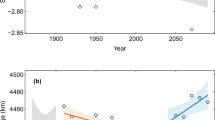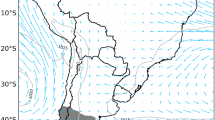Abstract
The negative relationship between similarity and distance has been revealed in many subjects in geography and ecology fields. This study aimed to illustrate the strength of the distance-decay relationship in variation of climate and vegetation, and to quantify the relationship. Solving this problem could help to test some model specifications based on the climate and vegetation time series on sample sites, to determine the distance function in the spatial interpolation technique for meteorological factors and vegetation dynamics, and to use the distance-decay perspective as a quantitative technique to adapt strategies for future climate change and vegetation dynamics. To achieve the study goal, we quantified variation similarity using mutual information (MI), which measured the dependence between two variables or time series. We carried out a distance-decay analysis of climate and NDVI variation similarities, assessed by the MI against the log-transformed geographical distances between meteorological stations. The results suggest that all station pairs shared some similarity in the processes of climate variation and vegetation dynamics, and the MI values showed a gradual decrease with the increase of distance. In addition, temperature, precipitation, and NDVI time series had different MI value ranges and distance-decay ratios due to various influential factors. The logarithmic distance-decay relationships are of potential usefulness to the study of community similarity and the neutral theory of biogeography. Our research provides an approach for analyzing spatial patterns in relation to dependence and synchronization that may inform future studies aiming to understand the distribution and spatial relationship of climate and vegetation changes.





Similar content being viewed by others
References
Astorga A, Oksanen J, Luoto M, Soininen J, Virtanen R, Muotka T (2011) Distance decay of similarity in freshwater communities: do macro-and microorganisms follow the same rules? Global Ecol Biogeogr 21(3):365–375
Baigorria GA, Jones JW (2010) GiST: a stochastic model for generating SPATIALLY and temporally correlated daily rainfall data. J Clim 23(22):5990–6008. doi:10.1175/2010jcli3537.1
Baigorria GA, Jones JW, O’Brien JJ (2007) Understanding rainfall spatial variability in southeast USA at different timescales. Int J Climatol 27(6):749–760. doi:10.1002/Joc.1435
Baselga A (2007) Disentangling distance decay of similarity from richness gradients: response to Soininen et al. 2007. Ecography 30:838–841
Bjorholm S, Svenning JC, Skov F, Balslev H (2008) To what extent does Tobler’s 1st law of geography apply to macroecology? A case study using American palms (Arecaceae). BMC Ecol 8(1):11
Brown ME, Pinzon JE, Didan K, Morisette JT, Tucker CJ (2006) Evaluation of the consistency of long-term NDVI time series derived from AVHRR, SPOT-vegetation, SeaWiFS, MODIS, and Landsat ETM + sensors. Geosci Remote Sens IEEE Trans 44(7):1787–1793. doi:10.1109/TGRS.2005.860205
Chen WR, Henebry GM (2010) Spatio-spectral heterogeneity analysis using EO-1 Hyperion imagery. Comput Geosci UK 36(2):167–170. doi:10.1016/j.cageo.2009.05.005
Chen F, Yuan Y, Wen W, Yu S, Fan Z, Zhang R, Zhang T, Shang H (2012) Tree-ring-based reconstruction of precipitation in the Changling Mountains, China, since ad 1691. Int J Biometeorol 56(4):765–774
Cody ML (1975) Towards a theory of continental species diversities: bird distributions over Mediterranean habitat gradients. Ecol Evol Communities 214:257
Costantini ML, Zaccarelli N, Mandrone S, Rossi D, Calizza E, Rossi L (2012) NDVI spatial pattern and the potential fragility of mixed forested areas in volcanic lake watersheds. Forest Ecol Manag 285:133–141. doi:10.1016/j.foreco.2012.08.029
Cover TM, Thomas JA (2006) Elements of information theory, 2nd edn. Wiley-interscience, New York
Cressie N (1993) Statistics for spatial data. Wiley, New York
Davies RG, Orme CDL, Storch D, Olson VA, Thomas GH, Ross SG, Ding TS, Rasmussen PC, Bennett PM, Owens IPF (2007) Topography, energy and the global distribution of bird species richness. Proc R Soc B Biol Sci 274(1614):1189–1197
Domroes M, Ranatunge E (1993) Analysis of inter-station daily rainfall correlation during the southwest monsoon in the wet zone of Sri-Lanka. Geogr Ann A 75(3):137–148
Dornelas M, Connolly SR, Hughes TP (2006) Coral reef diversity refutes the neutral theory of biodiversity. Nature 440(7080):80–82
Duque A, Phillips JF, von Hildebrand P et al (2009) Distance decay of tree species similarity in protected areas on terra firme forests in Colombian Amazonia. Biotropica 41:599–607
Evans KL, James NA, Gaston KJ (2006) Abundance, species richness and energy availability in the North American avifauna. Global Ecol Biogeogr 15(4):372–385
Geerken R, Zaitchik B, Evans JP (2005) Classifying rangeland vegetation type and coverage from NDVI time series using Fourier Filtered Cycle Similarity. Int J Remote Sens 26(24):5535–5554. doi:10.1080/01431160500300297
Gilbert B, Lechowicz MJ (2004) Neutrality, niches, and dispersal in a temperate forest understory. Proc Natl Acad Sci USA 101(20):7651–7656. doi:10.1073/pnas.0400814101
Gurgel HC, Ferreira NJ (2003) Annual and interannual variability of NDVI in Brazil and its connections with climate. Int J Remote Sens 24(18):3595–3609. doi:10.1080/0143116021000053788
Hofstra N, New M (2009) Spatial variability in correlation decay distance and influence on angular-distance weighting interpolation of daily precipitation over Europe. Int J Climatol 29(12):1872–1880. doi:10.1002/Joc.1819
Jarlan L, Mangiarotti S, Mougin E, Mazzega P, Hiernaux P, Le Dantec V (2008) Assimilation of SPOT/VEGETATION NDVI data into a sahelian vegetation dynamics model. Remote Sens Environ 112(4):1381–1394. doi:10.1016/j.rse.2007.02.041
Kadmon R, Pulliam HR (1993) Island biogeography: effect of geographical isolation on species composition. Ecology 74(4):978–981
Kerr JT, Ostrovsky M (2003) From space to species: ecological applications for remote sensing. Trends Ecol Evol 18(6):299–305
Kraskov A, Stögbauer H, Grassberger P (2004) Estimating mutual information. Phys Rev E 69(6):066138
Legendre P, Legendre L (1998) Numerical ecology, 2nd English edn. Elsevier Science, Amsterdam
Lhermitte S, Verbesselt J, Jonckheere I, Nackaerts K, van Aardt JAN, Verstraeten WW, Coppin P (2008) Hierarchical image segmentation based on similarity of NDVI time series. Remote Sens Environ 112(2):506–521. doi:10.1016/j.rse.2007.05.018
Lhermitte S, Verbesselt J, Verstraeten WW, Coppin P (2011) A comparison of time series similarity measures for classification and change detection of ecosystem dynamics. Remote Sens Environ 115(12):3129–3152. doi:10.1016/j.rse.2011.06.020
Li SC, Zhao ZQ, Wang Y, Wang YL (2011) Identifying spatial patterns of synchronization between NDVI and climatic determinants using joint recurrence plots. Environ Earth Sci 64:851–859
Lichstein JW (2007) Multiple regression on distance matrices: a multivariate spatial analysis tool. Plant Ecol 188(2):117–131
Lobo A, Maisongrande P (2008) Searching for trends of change through exploratory data analysis of time series of remotely sensed images of SW Europe and NW Africa. Int J Remote Sens 29(17–18):5237–5245. doi:10.1080/01431160802036441
Mantel NA (1967) The detection of disease clustering and a generalized regression approach. Cancer Res 27:209–220
Martinez B, Cassiraga E, Camacho F, Garcia-Haro J (2010) Geostatistics for mapping leaf area index over a cropland landscape: efficiency sampling assessment. Remote Sens Basel 2(11):2584–2606. doi:10.3390/Rs2112584
Maselli F, Chiesi M (2006) Integration of multi-source NDVI data for the estimation of Mediterranean forest productivity. Int J Remote Sens 27(1):55–72
Millward AA, Kraft CE (2004) Physical influences of landscape on a large-extent ecological disturbance: the northeastern North American ice storm of 1998. Landsc Ecol 19(1):99–111
Morlon H, Chuyong G, Condit R, Hubbell S, Kenfack D, Thomas D, Valencia R, Green JL (2008) A general framework for the distance-decay of similarity in ecological communities. Ecol Lett 11(9):904–917
Myneni R, Tucker C, Asrar G, Keeling C (1998) Interannual variations in satellite-sensed vegetation index data from 1981 to 1991. J Geophys Res 103(D6):6145–6160
Nekola JC, White PS (1999) The distance decay of similarity in biogeography and ecology. J Biogeogr 26(4):867–878
Palmer MW (2005) Distance decay in an old-growth neotropical forest. J Veg Sci 16:161–166
Prates-Clark CD, Saatchi SS, Agosti D (2008) Predicting geographical distribution models of high-value timber trees in the Amazon Basin using remotely sensed data. Ecol Model 211(3–4):309–323. doi:10.1016/j.ecolmodel.2007.09.024
Shannon CE, Weaver W (1949) The mathematical theory of communication (Urbana, IL). Univ Ill Press 19(7):1
Soininen J, McDonald R, Hillebrand H (2007) The distance decay of similarity in ecological communities. Ecography 30(1):3–12
Sui DZ (2004) Tobler’s first law of geography: a big idea for a small world? Ann Assoc Am Geogr 94(2):269–277
Tobler WR (1970) A computer movie simulating urban growth in the Detroit region. Econ Geogr 46:234–240
Tuomisto H, Ruokolainen K, Yli-Halla M (2003) Dispersal, environment, and floristic variation of western Amazonian forests. Science 299(5604):241–244. doi:10.1126/science.1078037
Viedma O, Torres I, Perez B, Moreno JM (2012) Modeling plant species richness using reflectance and texture data derived from QuickBird in a recently burned area of Central Spain. Remote Sens Environ 119:208–221. doi:10.1016/j.rse.2011.12.024
Vuilleumier F (1970) Insular biogeography in continental regions. I. The northern Andes of South America. Am Nat 104(938):373–388
Walsh SJ, Crawford TW, Welsh WF, Crews-Meyer KA (2001) A multiscale analysis of LULC and NDVI variation in Nang Rong district, northeast Thailand. Agr Ecosyst Environ 85(1–3):47–64
White MA, De Beurs KM, Didan K, Inouye DW, Richardson AD, Jensen OP, O’Keefe J, Zhang G, Nemani RR, Van Leeuwen WJD, Brown JF, De Wit A, Schaepman M, Lin X, Dettinger M, Bailey AS, Kimball J, Schwartz MD, Baldocchi DD, Lee JT, Lauenroth WK (2009) Intercomparison, interpretation, and assessment of spring phenology in North America estimated from remote sensing for 1982–2006. Glob Change Biol 15(10):2335–2359. doi:10.1111/j.1365-2486.2009.01910.x
Whittaker RH (1975) Communities and ecosystems. MacMillan Publishing, New York
Zhang X, Hu Y, Zhuang D, Qi Y (2009) The spatial pattern and differentiation of NDVI in Mongolia Plateau. Geogr Res Aust 1:002
Zhao ZQ, Gao JB, Wang YL, Liu JG, Li SC (2014) Exploring spatially variable relationships between NDVI and climatic factors in a transition zone using geographically weighted regression. Theoret Appl Climatol. doi:10.1007/s00704-014-1188-x
Acknowledgments
This study was financially supported by grants from the National Natural Science Foundation of China (NSFC, Nos. 41330747 and 41130534) and China Postdoctoral Science Foundation funded project (2014M560014). The authors are grateful to the anonymous reviewers for offering valuable suggestions to improve the manuscript.
Author information
Authors and Affiliations
Corresponding authors
Rights and permissions
About this article
Cite this article
Zhao, Z., Li, S., Liu, J. et al. The distance decay of similarity in climate variation and vegetation dynamics. Environ Earth Sci 73, 4659–4670 (2015). https://doi.org/10.1007/s12665-014-3751-2
Received:
Accepted:
Published:
Issue Date:
DOI: https://doi.org/10.1007/s12665-014-3751-2




